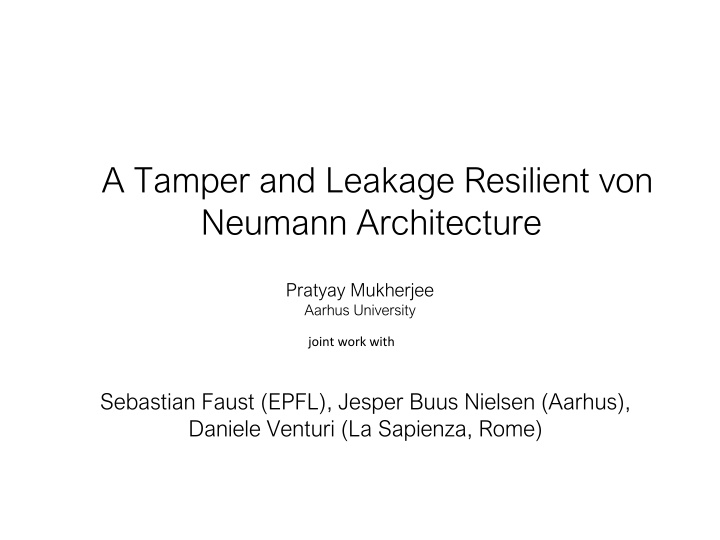
Tamper and Leakage Resilient von Neumann Architecture
This joint work discusses a tamper and leakage resilient von Neumann Architecture presented by Pratyay Mukherjee from Aarhus University in collaboration with Sebastian Faust (EPFL), Jesper Buus Nielsen (Aarhus), and Daniele Venturi (La Sapienza, Rome). The architecture addresses physical attacks on implementations, emphasizing the importance of protecting against tampering. It introduces an alternative model of computation, the von Neumann Architecture (vNA), which offers tamper and leakage resilience without storing any secrets, providing a general framework to compute keyed functionality. The approach aims to simplify analysis and enhance protection against tampering adversaries.
Download Presentation

Please find below an Image/Link to download the presentation.
The content on the website is provided AS IS for your information and personal use only. It may not be sold, licensed, or shared on other websites without obtaining consent from the author. If you encounter any issues during the download, it is possible that the publisher has removed the file from their server.
You are allowed to download the files provided on this website for personal or commercial use, subject to the condition that they are used lawfully. All files are the property of their respective owners.
The content on the website is provided AS IS for your information and personal use only. It may not be sold, licensed, or shared on other websites without obtaining consent from the author.
E N D
Presentation Transcript
A Tamper and Leakage Resilient von Neumann Architecture Pratyay Mukherjee Aarhus University joint work with Sebastian Faust (EPFL), Jesper Buus Nielsen (Aarhus), Daniele Venturi (La Sapienza, Rome)
Physical Attack on implementations Traditional Crypto: Blackbox Reality: Physical Attacks Main focus tampering Implement input leakage tampered output output
Why care about tampering? BDL 01: Inject single (random) fault to the signing-key of some type of RSA-sig Factor RSA-modulus ! More Anderson and Kuhn 96 Skorobogatov et al. 02 Coron et al. 09 and many more . Devastating attacks on Provably Secure Crypto-systems!
Theoretical Models of Tampering Memory only tampering (GLMMR 04) Tamper with both memory and computation (IPSW 06) F F k k Easier analysis. Lot of positive results In practice hard to guarantee. This talk This talk
Earlier approach: protect circuits against tampering Approach: Model computation as circuits: build circuit compiler which transforms any C to C which is protected against tampering First initiative by IPSW06: protects against constant number of wire faults Current best: DK14: Protects against tampering of (1/poly)-fraction of all wires. Analysis complicated: involves tools like PCP. Our goal: simpler framework stronger tampering adversary
Our approach An alternative model of computation: von Neumann Architecture (vNA)/ Random Access Machine (RAM) P= (P[1],P[2], ) P[1] P[2] CPU Bus Disk
Tamper and leakage resilient vNA P[1] P[2] NO leak/tamper CPU Bus CPU Disk small and universal Does not store any secret. otherwise simple solution ! stores an untamperable special purpose bit.
Our results A general framework to compute any keyed functionality in a tampering-leakage environment. Reducing the problem of shielding arbitrary complex computations to protecting a single, simple,universal component (CPU): Similar in spirit with leakage-resilient computations (GR10) We construct a compiler which turns program P for ideal vNA to a program P for vNA under tampering: using non-malleable codes (black-box) DLSZ15: A concurrent and independent work Locally Decodable and Updatable Non-Malleable Codes and Their Applications
The security notion P P compiler REAL IDEAL
Modular approach: Hybrid world P[1] Q CPU P[4] No leakage Mild tampering: 1. COPY within disk 2. Overwrite
Our construction: Two steps P= (P[1],P[2], ) Step-1 Compiler P P Ideal I->H Compiler Hybrid Step-2 P P Real Hybrid H->R Compiler
Step-1: Ideal to Hybrid compiler P= (P[1],P[2], ) P = (P [1],P [2], ) Hybrid Ideal Recall : in hybrid model there is only limited tampering: 1. COPY 2. OVERWRITE Augment each P[i] by appending: A secret level L Binds the instructions and secrets Guarantees that if the adversary overwrites instructions, it has to overwrite secrets. Otherwise one can just overwrites instructions to output secrets.
Step-1: Ideal to Hybrid compiler P= (P[1],P[2], ) P = (P [1],P [2], ) Hybrid Ideal Recall : in hybrid model there is only limited tampering: 1. COPY 2. OVERWRITE Augment each P[i] by appending: A secret level L The position i Protect against copying from one location to another
Step-2: Hybrid to Real compiler P = (P [1],P [2], ) Hybrid P = (P [1],P [2], ) Real Idea: Encode each P [i] such that the adversary can only copy or overwrite Encode using Non-malleable codes Guarantees that if the adversary does not copy the encoding then only can overwrite Non-malleable Codes (DPW10) An encoding (ENC, DEC) is non-malleable w.r.t. a function family if the following holds Then is equal or unrelated to
A suitable instantiation of Non-malleable codes Since the same encoding can be tampered multiple times we will need continuous non-malleable codes Continuous Non-malleable Codes: introduced by FMNV14 Construction works for split-state : codeword has two parts which are independently temperable Needs Common Random String Needs self-destruct
Implementing vNA via FMNV14 code (P [i][1],P [i][2])< ENC(P [i]) P [1][1] P [2][1] P [1][2] P [2][2] NO leak/tamper P [i] accessed bounded no. of times. CNMC protect against bounded leakage CPU Bus Bus Disk-1 Disk-2 the self-destruct flag CPU CRS is part of description and hardwired. stores one untamperable special purpose bit.
Summarizing.. We propose a new framework of protecting computations against tampering (and leakage). Our architecture can withhold significantly stronger tampering: (split-state) than the circuit-oriented approach. Since our transformation from Hybrid to Real uses the CNMC in blackbox way, better construction will improve the overall construction. Future direction: CPU size depends linearly on sec-param since it has to execute DECODE of CNMC. Can we get constant?
